We independently evaluate all recommended products and services. Any products or services put forward appear in no particular order. If you click on links we provide, we may receive compensation.
“Classic” is a word that pinpoints a product to its legacy. Titanium, frame lock, and phosphor bronze washers are words that, spoken in succession 31 years ago, would allude to very few knives in that era. Today, in 2020, we live in a knife world that is dense with knives boasting these traits. To me, however, the most quintessential knife in this category, will always be the Chris Reeve Knives Sebenza.

There’s really no comparison in terms of machining tolerances, when referring to Chris Reeve Knives. Well, there is, but the aerospace industry’s standards are just below what the CRK tolerances call for. This gives their knives a feeling of solidity second only to a fixed blade. The term “frame lock” (or Reeve Integral Lock, as it was originally dubbed) commonly used and referred to on folding knives, was invented by Chris Reeve. The steel on the blades (currently sporting Crucible’s S35VN), is a slight evolution of S30V, a recipe that was partially developed by Chris Reeve.
The company motto, “think twice, cut once” is not just a mantra to repeat mindlessly, but rather a reflection on how the company is run as a whole. Take these attributes, along with some heavy research and development, accompanied by a pair of titanium slabs, just about rounds out the recipe to produce the Sebenza. The original folding knife created by Chris Reeve.
Key Specs: Chris Reeve Sebenza 21
The Blade
The blade on the Sebenza comes in at either 2.94” or 3.625, depending on which of the two available sizes you’re looking at, the small or large. It’s steel is formulated out of the previously mentioned S35VN. This steel was regarded as a “super steel” (a term many are now tired of), in its heyday. It’s an upgrade to Chris Reece’s preciously used S30V in a few ways, namely by reducing the vanadium content, adding a dash of niobium (0.5%), and dropping the nitrogen. This chemical makeup change took the Sebenza’s blade into a slightly higher toughness level, making it marginally easier to sharpen, at a cost of minor edge retention loss. So, in terms of blade steel, it’s very well rounded just like the Sebenza as a whole.

Along with the two sizes available on the Sebenza, there are 3 blade shapes to choose from as well – drop point, tanto, and insingo. I could write a whole article on each blade just by itself, but I won’t bore you with all that verbiage.
The insingo on our sample Sebenza is kind of a hybrid between a modified sheepsfoot and a reverse tanto. The spine flows out away from the handle in a straight, parallel manner, and drops down near the tip. As the spine drops, in comes a swedge ground in to the top section of the tip, to make piercing effortless in use. The tip is not centered in reference to the handle, rather a little lower down. This blade has proven to be extremely versatile in daily use in my 3 part test mediums. The way the tip drops down allows it to remain fairly flat in the users hand without having to tip the butt of the handle way up in the air to open packages. It’s got a lot of that wharncliffe goodness, with a little curve in the belly, giving it a high level of functionality in most instances.
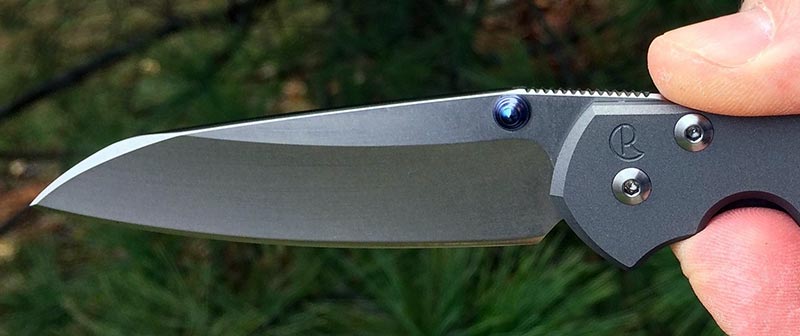
The tanto blade shape option is my least favorite in use, but the best looking. It boasts the same high end crowned spine found on the insingo and drop point blades, but the tanto is nearly straight all the way down the spine. The belly is slightly curved, and of course juts back upward to meet the tip with a secondary flat edge. This puts the tanto tip closer in line to the top of the handle, opposite of the insingo. The tip is very thick, lending itself to a more “hard use” type of personality, with very little material removed in that area. It does look elegantly sinister, though.
Now to the drop point blade. It’s the original Sebenza blade shape. A true classic in terms of shape, look, and utmost functionality. It swoops from the belly softly from the handle to the tip. The spine comes out straight from the handle, and drops down near the tip to meet the belly close to the center line relative to the handle. It’s beautifully boring, yet holds the title for the most functional blade I’ve handled in a folder. The hollow grind found on all 3 blade shapes lends the blade to an easy initial cut on material, then gets out of its own way to allow material to pass by, while still leaving some flat to the side of the blade near the spine.
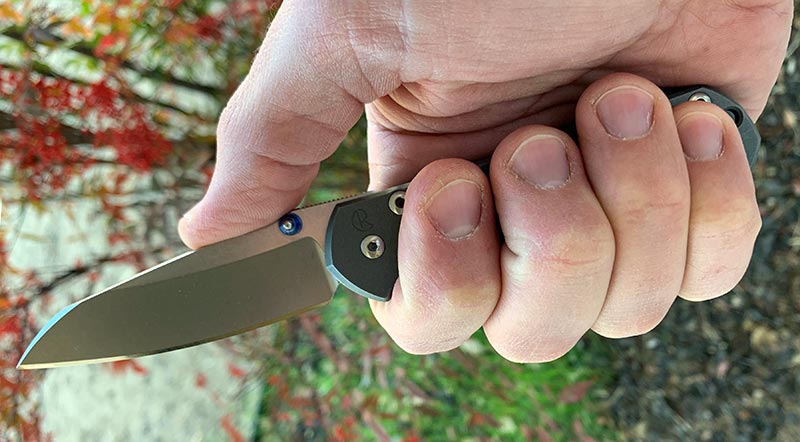
The hollow grind has another attribute unique to the CRK knife line- it gets thinner before it gets thicker. Just like all other parts of the Sebenza, this was an extremely well thought out implementation of design. Serving as another bullet point on reasons why the Sebenza is built to last a lifetime, the grind on the blade will actually get thinner with subsequent sharpening. That is not something that can be found on any other blade I’ve come across in my meanderings with pocket knives.
This particular detail is something that proves to me that Chris Reeve was not just another knife maker looking to cash in on a product. He wanted to make something that people could use, sharpen on their own, and keep using. This small detail is overlooked too often, not because it’s the most important part of the design, but because of what it means to implement something like this. He wanted to sell a knife that he would have wanted.

The Sebenza blade, whether it’s a small or large, tanto, drop point or insingo, is an eye-pleasing piece of steel. It possesses a well rounded formula of toughness, ease of sharpening, stainless properties, and edge retention. Is it yesterday’s “super steel”? Definitely. S35VN was looked up to by steel nerds on all corners of the knife world when it came out in 2009. Now, in 2020, it’s looked down upon by many steel gurus and sharpeners, and gets regurgitated over and over on forums and YouTube videos. But, it’s still a great daily carry steel, and a solid choice for the vast majority of use in most of our real-life daily use of a pocket knife.
Deployment and Lockup
The Sebenza continues its minimalist design with the small, stepped conical thumb stud. On most examples of the Sebenza, it’s a blue anodized lug that gives you purchase on a closed blade, to push it open. And it’s only on one side of the blade. C’mon CRK. Yes, it’s possible to order a Sebenza with a thumb stud on both sides of the blade, but it’s more or less a special order, and much less common to find in the wild when perusing the secondary market (where I spend most of my life). But I digress.
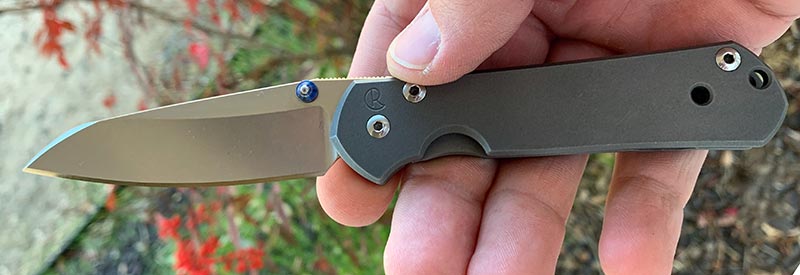
Using the common thumb-pushing method we’re all accustomed to, the blade pops crisply out from its detent, and with a glass-on-oily-glass smoothness, and sharply snaps into the locked open position. The RIL (Reeve Integral Lock), or now more commonly referred to as the frame lock, has an interface between the blade and the integrated lock bar on the handle scale, that is so precisely fit, there is absolutely no blade play in any direction.
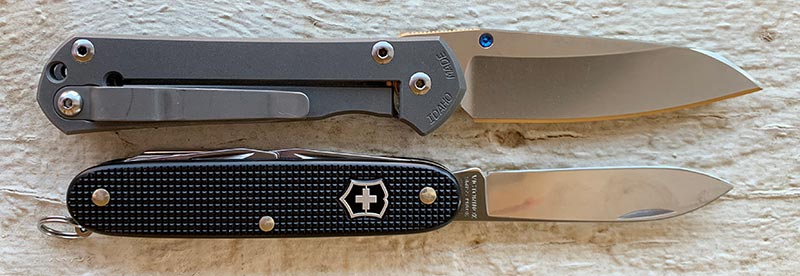
The lock interface on the Sebenza is a junction between two materials that proudly boasts precision. I’ve personally never handled a Sebenza with lock stick, yet the knife feels like a fixed blade when the blade is locked open. That’s another point that can be chalked up to the neurotic level of tolerances used in the Ohio based factory. Sebenzas typically lock up in the 50-65% range, meaning about half the blade is covered by the lock bar when the knife is open. In my eyes, that’s how a frame lock should be designed.

I see so many knives with some ridiculously early lockup (with maybe 15% of the blade touching the lock bar), and many people seem to be okay with that. I understand that with proper machining and tight tolerances, early lockup may not be an inherently bad thing. But, if for some reason the blade takes some heavy downward force, transferring energy into the lock bar, the harder material of the blade risks blowing that lock bar material right out of its way, sending the blade back into the closest finger it can find. Is that really a concern with a daily carry, folding knife? Probably not. But nobody plans to be in a car accident, either. I’d rather know my blade is going to stay where I put it, and isn’t going to argue with me no matter what my blade may hit during use, whether it be intentional or accidental in nature.
Features, Fit and Finish
The list of features on the Sebenza is relatively short. There’s a double retention point pocket clip, 2 perforated oversized phosphor bronze washers, a pivot bushing, two slabs of 6Al4V titanium, and some screws. The subdued look of the Sebenza is paralleled by its rather stagnant feature list. But, these features converge with the high end fit and finish put on the knife, for a feel that truly transfers it’s precision manufacturing into the hand. And that’s where the Sebenza starts to really make sense.

The titanium handle scales have a small chamfer all the way around the edges, giving the extremely flat design a feel that is much more contoured. This gives the knife a thin profile, while still having an overall feel to the handle that is comfortable in most any grip. The neutral design of the handles, with their mostly stick-like appearance, is one that offers hands of any size to grab the knife in any grip and still be comfortable. You look at something like a Spyderco Manix 2 and you may think “wow, that’s an ergonomic looking handle”. And it is. But only if you hold it exactly how the finger grooves tell you to. If you’re like me, and you like to occasionally use a pinch grip, something like the Manix 2 just feels like the knife is working against you. The bead blasted titanium scales of the Sebenza are very subdued and subtle in design, but very well thought out.
 Oh, that pocket clip. Who would’ve thought you could care so much about a pocket clip on a pocket knife? It seems so utilitarian. Shadowed by blade steel, action, materials, and modern features, pocket clips seem so secondary in thought. But to me, Chris Reeve put just as much care into designing the pocket clip and it’s placement as he did with every other part of the knife. There are two separate points at which the clip dips down toward the handle scale, then continue their path back toward the end. When putting a Sebenza into the pocket, the clip initiates easily with the first lip, then quite literally locks into position with the second dip of the clip.
Oh, that pocket clip. Who would’ve thought you could care so much about a pocket clip on a pocket knife? It seems so utilitarian. Shadowed by blade steel, action, materials, and modern features, pocket clips seem so secondary in thought. But to me, Chris Reeve put just as much care into designing the pocket clip and it’s placement as he did with every other part of the knife. There are two separate points at which the clip dips down toward the handle scale, then continue their path back toward the end. When putting a Sebenza into the pocket, the clip initiates easily with the first lip, then quite literally locks into position with the second dip of the clip.
The Microtech Socom Elite (another knife I love, and wish I hadn’t sold… twice) is one of the only other knives I’ve seen with this style of clip. And of course Mr. Reeve was first. This clip, completing the monotone, uniform titanium outfit, has the same color and bead blasting that the handle scales have. Once again, boring? Not to me. I don’t like a knife that’s in my pocket to be so loud in appearance that it tells everyone around me that I’m carrying a knife. And this one doesn’t.
Its position allows the butt of the handle to sit fairly low in the pocket, and while it’s not technically “deep carry, bro”, it’s low enough to sit quietly, securely, and comfortably until I need it. Especially with the small line of Sebenzas, at 2.7oz with inlays or 3oz on the plain titanium version, you can really forget you’re carrying it. And that’s what I want my pocket knife to do. Be there for me when I need it, and be well-mannered while being carried in the pocket.
The bushing pivot on the Sebenza is a design that isn’t used a whole lot in modern folders. Is it necessary? No. But neither is a $375, 3” pocket knife. And that’s how the Sebenza’s pivot parallels the knife as a whole. The bushing pivot is a round piece of metal that goes between the hole in the blade and the pivot screw. This aids in that hydraulic, fluid action.

The knife comes with fluorinated grease in the pivot, and comes with a small tube of it (along with disassembly tools, a high end microfiber cloth, and some paperwork) for the user to take the knife down whenever you may see fit, service it, and reassemble. CRK encourages this. Get to know your tool. Take it apart. And if you have a problem, send it in, even disassembled, and they’ll send it back in one piece. The bushing pivot arguably gives the blade more rigidity and stability, y’know, for when you can find your crowbar and have to pry a couple 2×4’s apart (yes, it can do that too – https://youtu.be/dwxoe3Kpv0w).
Of course that’s not what your $375-550 pocket knife is for, but this is proof that tight tolerances, a well designed bushing pivot, and oversized, perforated washers will do for the strength and rigidity of the knife. There’s no adjusting the pivot tension here either, because that bushing is so precisely fit, the pivot screw gets tightened all the way down, every time, and you’re done. And guess what. The blade is centered, action is smooth, and it locks up tight, every time.
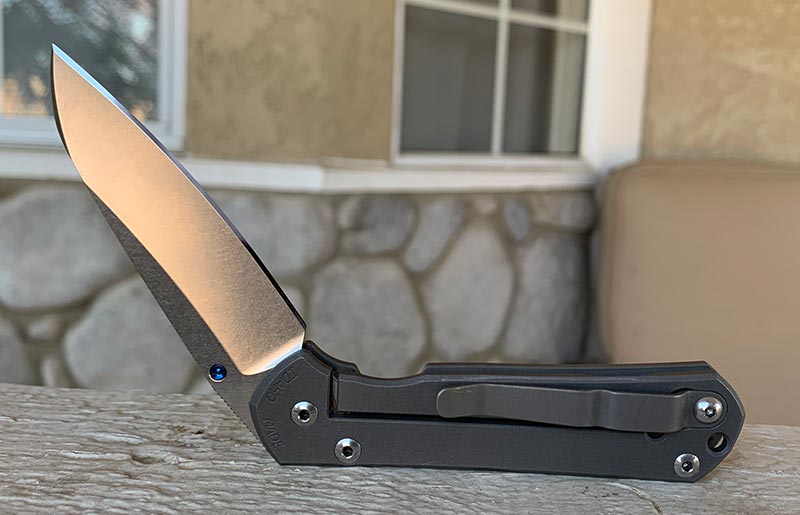
The screws on the Sebenza are all the same. All of them. The pocket clip screw, the pivot screw, the blade stop screw, all the same. And they all use the same, included 5/64 Allen key to disassemble. This is a true knife users dream. I have a tool box with all kinds of other tools, which is primarily a graveyard of torx bits that are missing teeth or twisted up from globs of loctite. I carry an extra single 5/64 Allen wrench in my wallet for the Sebenza (yeah, I’m that guy), and I can tighten any loose screw on the fly, or even do some disassembly while I’m out working if I needed to. I rarely do this, but I know I don’t have to go hunt down some random tool to get my knife back in order.
Field Test
I love using the Sebenza. It fits my hand well (both the large and the small). The hollow ground blade slices with the utmost capability. The steel won’t patina or rust in most day-to-day usage. The stonewashed blade finish hides scratches and doesn’t send rays of light bouncing half a mile away. It doesn’t look “tactical” or evil. It just looks like a knife. And it works famously for my 3-part field test.
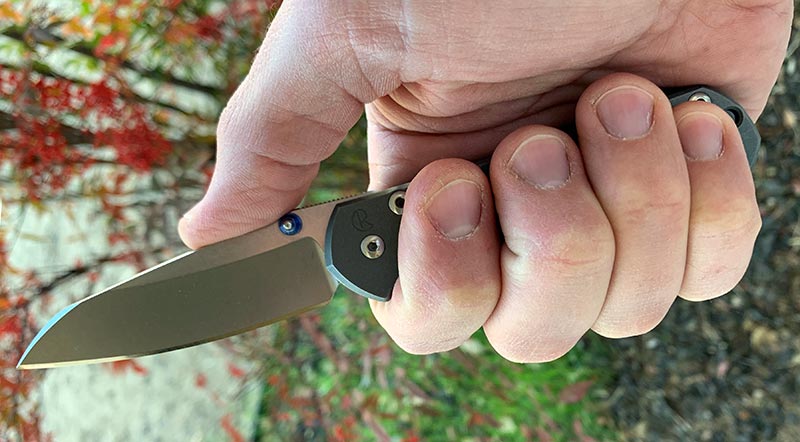
It’ll puncture a cardboard box with minimal effort with the insingo or drop point blade, although the tanto tip is as thick as bacon at a country diner. But the hollow grind on all 3 blade shapes slice through single or double walled cardboard without complaining much at all. It’ll zip right through all those Amazon boxes piling up in the garage with ease. Apple slicing proved to be routine for the Sebenzas too, with clean cuts, and no cracking in the slices (again, with exception to the tanto, which just wants to ruin everything in its path).
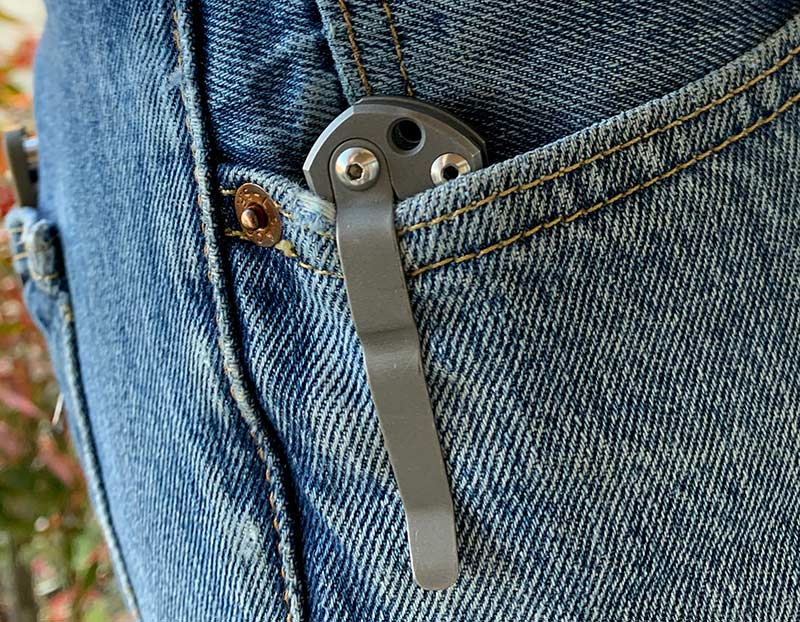
The wood carving into a 2×4 is the third task I run my knives through. And again, the hollow grind of the Sebenza bites into the material, and gets out of its own way to remove the desired material without much thought. And that beautifully neutral, stick-like handle doesn’t give me any hit spots to whine about at the end of the cutting session.
Alternatives
All these knives available at BladeHQ.
Here’s where the Sebenza has to stand up and face its competitors. There are so many knives out there, from so many great companies, we could talk all day about what the Sebenza compares to. But, for sake of brevity, let’s keep it to the “big three”- Hinderer, CRK, and Strider. Rick Hinderer’s XM-18 and Mick Strider’s SnG (now discontinued) are the two most commonly compared knives when considering alternatives to the Sebenza.
The XM-18 is offered in a 3” or 3.5” blade, similar to the Sebenza. The XM-18 is also available in more blade shapes (like spanto, slicer, harpoon, and Bowie) than the Sebenza. It’s offered in more blade steels, like 20CV (a much more wear resistant steel than the aforementioned S35VN on all CRK’s), and has “skinny” versions available along with a tri-way pivot system. So yeah, Rick definitely reaches a much bigger audience with the nearly limitless options offered on his folders, as well as the infinite number of scale replacements and even screw colors you can buy, even in the aftermarket world. The Sebenza can be had with unique graphic models, or many inlay choices, but they’re all the same blade shape, steel, and overall look.

Though discontinued with the closure of Strider knives in 2017, the SnG can still be had in the aftermarket. ProTech also now produces a cheaper version. Just as with Hinderer’s line, the SnG had countless blade grinds, a few different blade steels, and lots of different handle scale materials to choose from, like aluminum and G10. All three of these lines, the SnG, XM-18, and Sebenza, are very closely priced, in the $400-500 range. Yes, that range can deviate out of that price point, but the base models compare closely. But, look closer, at Hinderer’s grind and you’ll see the thickness behind the edge is fat enough to cause binding when cutting cardboard, or heavy splitting when slicing an apple. The SnG has a blade stock that’s so thick (.165 vs the Sebenza’s .13), it’ll surely break an apple apart in pieces. I will give credit to the SnG in regards to its grind though; it’s very thin behind the edge, giving it cardboard-cutting-capability that absolutely rivals the Sebenza.
Conclusion
“The worker” is the English translation of the Zulu word “Sebenza”. Chris Reeve designed a pocket knife 31 years ago, to be a working, long lasting, simplistically designed tool. It’s gone through subtle changes in that time, and the Sebenza 31 is its replacement, as the Sebenza 21 is now discontinued. I’ve verified with CRK that they’re still performing warranty work on the 21’s with back stock of parts as needed, and will continue to service the 21 as long as they’re around.

The Sebenza has been the knife to beat, and the standard to which most other knives have been compared to, for quite literally decades. Is it time, now, for that reign of power to end? Yes and no. Chris Reeve invented the frame lock, and was heavily involved in the composition of two big-name knife steels. He took his fixed blades and knowledge from South Africa over 3 decades ago, brought it to the USA, and showed the world what he could do. And we ate it up, and we still do.
The Chris Reeve Knives Sebenza 21 was an evolution on the 21st year of its production. It will remain a standard in the knife world forever, at least in its legacy. It’s still prominent in today’s market, but the alternative choices are becoming more and more competitive. It’s not that it’s not worth the money, but for the same wad of cash you can surely find lots of other closely comparable cutters. I still believe it’s a great choice for a tool that does what it’s made to do- be carried, used, maintained, and enjoyed. When it comes to what the Sebenza is all about, it’s not really a matter of what’s necessary, but rather what’s best. It’s made to last and to be passed on to the next generation, just as Chris Reeve has passed the business on to his son, Tim.
- A deep hollow ground blade that’s well heat treated, stonewashed, and elegantly hard working. A handle that you can grab in any grip and use it comfortably. A pocket clip that tucks the knife away securely, until you need it. A lock you can truly trust and an action that sets the standard in smoothness. This is a knife you can really use without fear, and keep with you for a lifetime.
- Expensive at $450 for a knife with very few features and options when you look elsewhere. Several competitors with high level manufacturing quality, blade steel and shape options, features, and pricing. Large Sebenza a bit heavy at 4.7oz for a true EDC. It’s not fidget-friendly, although it’s truly not designed to be. So yeah, it’s boring. Vanilla. Old school.
Chris Reeve Sebenza 21
Quality/Performance - 91%
Value for Money - 80%
86%
The Sebenza 21 was once the standard that all knives were measured against...and for good reason. Now put to rest but always legendary.
Reviewed by Mason Ball





